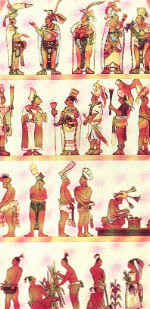|
|
Buildings were begun in Formative period, when architecture showed influences from other cultures, particularly Olmec. Later, Maya architecture was affected by mythical and religious ideas. This is why temples and places, citadels and ball courts were built in the center of cities, while houses of ordinary people stood on the outskirts.
It was in Classic period that the typical Maya features emerged, such as corbel or Maya arch, superposed terraces, moldings, roof crests and columns that in combination gave rise to several distinctive styles, known as:
Peten: Buildings standing on stepped terraces, thick walls, sloping sections, staircase projecting from facade, tall roof crests on the rear wall and decoration of stucco masks. This style is found on sites such as Calakmul in Mexico, and Tikal, Piedras and Uaxactun in Guatemala.
Palenque: Vertical base platforms, staircases with side ramps, facades decorated with stucco figures, roof crests on the central wall, temples with two rooms, the rear one being used as shrine. This style is found at Yaxchilan, Palenque and Bonampak in Mexico, at Copan in Honduras and Quirigua in Guatemala.
In 1952, a funeral chamber was discovered in Temple of Inscriptions at Palenque; in June 1994, another similarly magnificent one was opened cole by.
Rio Bec: Characterized by the use of stylized pyramidal bases, purely decorative stairways that look like high towers at the sides of the temple and decoration formed of stone mosaic. To be seen at Xpuhil, Rio Bec and Hormiguero in Mexico.
Chenes: Style that developed together with Puuc, so the two contain similar elements such as bases with sloping, stepped tiers, roof crests standing on the front part, columns and vertical friezes, and decoration based on stone mosaic forming masks, small columns, latticework, pillar drums and panels.
Present at Labna, Kabah, Uxmal, Sayil, Hochob and Edzna in Mexico. Some of the most beautiful buildings in this style are at Uxmal, such as Pyramid of Magician and Governor's Palace.
Puuc: Which differs mainly in decoration made of stone mosaic on the friezes, not on the entire facade.
Mexica or Maya-Toltec: This was the result of Toltec cultural influence, although it retains some Puuc elements. Features are high platforms and sloping walls, staircases with serpent heads at the bottom, and altars decorated with skulls: Chichen Itza, Tulum and Mayapan in Mexico.

|
|

